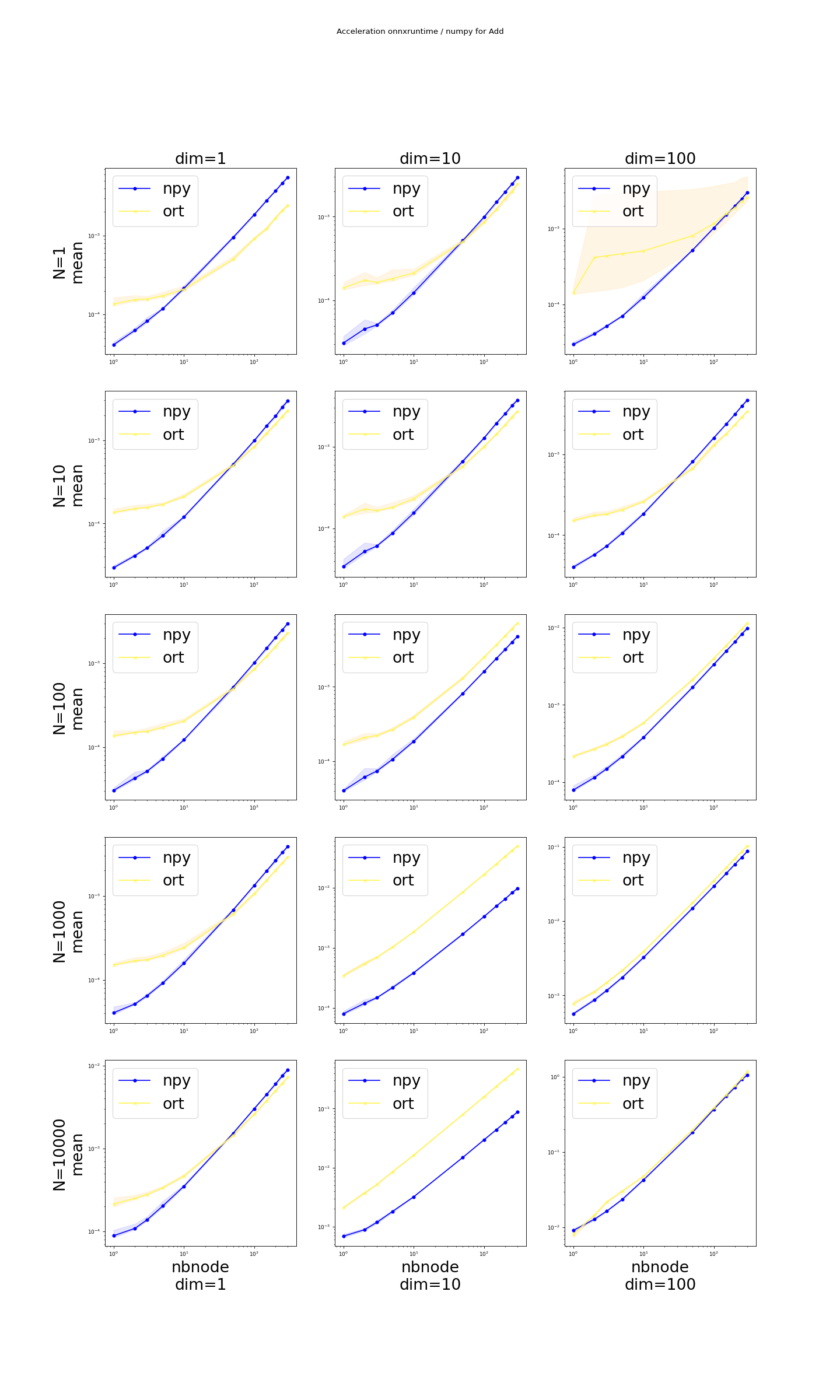Benchmark (ONNX) for Addition#
The experiment compares the execution time between numpy and onnxruntime for a series (or cascade) of additions.

k is named the number of nodes and the corresponding ONNX graph for k=2 or 4 looks like a cascade of operators Add. Both onnxruntime and numpy use BLAS functions.
k=2 |
k=4 |

|

|
Overview#
(Source code, png, hires.png, pdf)

Configuration#
<<<
from pyquickhelper.pandashelper import df2rst
import pandas
name = os.path.join(
__WD__, "../../onnx/results/bench_plot_onnxruntime_casc_add.time.csv")
df = pandas.read_csv(name)
print(df2rst(df, number_format=4))
>>>
name |
version |
value |
|---|---|---|
date |
2019-12-11 |
|
python |
3.7.2 (default, Mar 1 2019, 18:34:21) [GCC 6.3.0 20170516] |
|
platform |
linux |
|
OS |
Linux-4.9.0-8-amd64-x86_64-with-debian-9.6 |
|
machine |
x86_64 |
|
processor |
||
release |
4.9.0-8-amd64 |
|
architecture |
(‘64bit’, ‘’) |
|
mlprodict |
not-imported |
|
numpy |
1.17.4 |
openblas, language=c |
onnx |
1.6.34 |
opset=12 |
onnxruntime |
1.1.992 |
CPU-MKL-ML |
pandas |
0.25.3 |
|
skl2onnx |
1.6.992 |
|
sklearn |
0.22 |
Raw results#
bench_plot_onnxruntime_casc_add.csv
<<<
from pyquickhelper.pandashelper import df2rst
from pymlbenchmark.benchmark.bench_helper import bench_pivot
import pandas
name = os.path.join(
__WD__, "../../onnx/results/bench_plot_onnxruntime_casc_add.perf.csv")
df = pandas.read_csv(name)
piv = bench_pivot(df).reset_index(drop=False)
piv['speedup'] = piv['npy'] / piv['ort']
print(df2rst(piv, number_format=4))
Benchmark code#
bench_plot_onnxruntime_casc_add.py
# coding: utf-8
"""
Benchmark of :epkg:`onnxruntime` for a cascade of additions.
"""
# Authors: Xavier Dupré (benchmark)
# License: MIT
import matplotlib
matplotlib.use('Agg')
import os
import unittest
import warnings
import contextlib
from time import perf_counter as time
from io import StringIO
import numpy
import pandas
import matplotlib.pyplot as plt
import sklearn
from sklearn.utils._testing import ignore_warnings
from sklearn.utils.extmath import softmax
from pyquickhelper.loghelper import run_cmd, sys_path_append
from pymlbenchmark.benchmark import BenchPerfTest, BenchPerf
from pymlbenchmark.context import machine_information
from pymlbenchmark.datasets.artificial import random_binary_classification
from pymlbenchmark.plotting import plot_bench_results
from skl2onnx.common.data_types import FloatTensorType
from skl2onnx.algebra.onnx_ops import OnnxAdd
from onnxruntime import InferenceSession
from mlprodict import __max_supported_opset__, get_ir_version
################################
# Benchmark
# +++++++++
def generate_onnx_graph(dim, nbnode, input_name='X1'):
"""Generates a series of consecutive additions."""
matrices = []
i1 = input_name
for i in range(nbnode - 1):
i2 = random_binary_classification(1, dim)[0].astype(numpy.float32)
matrices.append(i2)
node = OnnxAdd(i1, i2, op_version=__max_supported_opset__)
i1 = node
i2 = random_binary_classification(1, dim)[0].astype(numpy.float32)
matrices.append(i2)
node = OnnxAdd(i1, i2, output_names=['Y'],
op_version=__max_supported_opset__)
onx = node.to_onnx([(input_name, FloatTensorType((None, dim)))],
outputs=[('Y', FloatTensorType((None, dim)))])
onx.ir_version = get_ir_version(__max_supported_opset__)
return onx, matrices
class GraphORtBenchPerfTest(BenchPerfTest):
def __init__(self, dim=4, nbnode=3):
BenchPerfTest.__init__(self)
self.input_name = 'X1'
self.nbnode = nbnode
self.onx, self.matrices = generate_onnx_graph(dim,
nbnode, self.input_name)
as_string = self.onx.SerializeToString()
self.ort = InferenceSession(as_string)
def fcts(self, **kwargs):
def predict_ort(X, model=self.ort):
return self.ort.run(None, {self.input_name: X})[0]
def predict_npy(X, model=self.matrices):
res = X.copy()
for mat in model:
res += X
return res
return [{'lib': 'ort', 'fct': predict_ort},
{'lib': 'npy', 'fct': predict_npy}]
def data(self, N=10, dim=4, **kwargs): # pylint: disable=W0221
return tuple(o.astype(numpy.float32)
for o in random_binary_classification(N, dim)[:1])
@ignore_warnings(category=FutureWarning)
def run_bench(repeat=20, number=10, verbose=False):
pbefore = dict(dim=[1, 10, 100],
nbnode=[1, 2, 3, 5, 10, 50, 100, 150, 200, 250, 300])
pafter = dict(N=[1, 10, 100, 1000, 10000])
test = lambda dim=None, **opts: GraphORtBenchPerfTest(dim=dim, **opts)
bp = BenchPerf(pbefore, pafter, test)
with sklearn.config_context(assume_finite=True):
start = time()
results = list(bp.enumerate_run_benchs(repeat=repeat, verbose=verbose,
number=number, stop_if_error=False))
end = time()
results_df = pandas.DataFrame(results)
print("Total time = %0.3f sec\n" % (end - start))
return results_df
#########################
# Runs the benchmark
# ++++++++++++++++++
filename = os.path.splitext(os.path.split(__file__)[-1])[0]
df = run_bench(verbose=True)
df.to_csv("%s.perf.csv" % filename, index=False)
print(df.head())
#########################
# Extracts information about the machine used
# +++++++++++++++++++++++++++++++++++++++++++
pkgs = ['numpy', 'pandas', 'sklearn', 'skl2onnx',
'onnxruntime', 'onnx', 'mlprodict']
dfi = pandas.DataFrame(machine_information(pkgs))
dfi.to_csv("%s.time.csv" % filename, index=False)
print(dfi)
#############################
# Plot the results by number of nodes
# +++++++++++++++++++++++++++++++++++
def label_fct(la):
la = la.replace("onxpython_compiled", "opy")
la = la.replace("onxpython", "opy")
la = la.replace("onxonnxruntime1", "ort")
la = la.replace("fit_intercept", "fi")
la = la.replace("True", "1")
la = la.replace("False", "0")
la = la.replace("max_depth", "mxd")
return la
from pymlbenchmark.plotting import plot_bench_results
plot_bench_results(df, row_cols='N', col_cols='dim',
x_value='nbnode',
title="%s\nBenchmark scikit-learn / onnxruntime" % "Cascade Add",
label_fct=label_fct)
plt.savefig("%s.node.png" % filename)
##################################
# Plot one ONNX graph
# +++++++++++++++++++
for nbnode in (2, 4):
onx = generate_onnx_graph(5, nbnode)[0]
from onnx.tools.net_drawer import GetPydotGraph, GetOpNodeProducer
pydot_graph = GetPydotGraph(onx.graph, name=onx.graph.name, rankdir="TB",
node_producer=GetOpNodeProducer("docstring"))
pydot_graph.write_dot("graph.%d.dot" % nbnode)
os.system('dot -O -Tpng graph.%d.dot' % nbnode)
image = plt.imread("graph.%d.dot.png" % nbnode)
plt.imshow(image)
plt.axis('off')
plt.savefig("%s.%d.node.png" % (filename, nbnode))
import sys
if "--quiet" not in sys.argv:
plt.show()